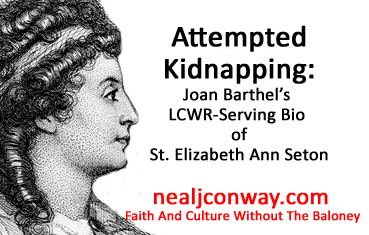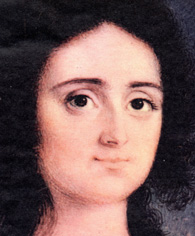 |
 |
|---|
Attempted Kidnapping: Joan Barthel's LCWR-Serving Bio of St. Elizabeth Ann Seton
(May 17, 2014)
Most people's conceptions of nuns are shaped by The Sound of Music. Most American Catholics old enough to have had interaction with sisters in Catholic schools still think of nuns as being habit-wearers who, despite virtuosity at connecting yardsticks to backsides, have sacrificed much of life's pleasures to do the dirty work of educating children or of caring for the poor or the sick. Few Catholics have read courageous journalist, Ann Carey's book, Sisters in Crisis: The Tragic Unraveling of Women's Religious Communities (1).
This is why most American Catholics have a hard time understanding that there are nuns and then there are nuns.
There are the habit-wearing sisters who live together in communities such as a) The Little Sisters of The Poor who are now fighting in court to prevent $1 million/day Obamacare fines that will snuff out their care for the poor and b) Sister Jane Dominic Laurel, OP, who has cancelled public appearances because of threats of harm against her after she proclaimed some inconvenient truths about human sexuality and modern family life.
Then there are nuns of the Leadership Conference of Women Religious (LCWR) and those of like mind, if not the same bodies, the "Nuns on the Bus." You won't find these nuns living in convents. Their kind broke up the convents and claimed there was a vocation shortage. These nuns live in apartments. You won't find them wearing habits.(*) They wear jewelry. You won't find these nuns taking care of the poor unless they want to make a media event of it. Caring for the poor is a job they believe that the government should do. Leadership Conference is what it says: LCWR is a club for nuns who are the bossy-bootses of religious orders, or nuns who are six-figure-earning executive directors of hospitals and of non-profits with vague or left-leaning purposes.
Many rank-and-file sisters do not approve of their orders' membership in LCWR or of the leadership acting like a coven, calling for change in church doctrine, honoring dissenters or spouting smart-sounding but kooky heresies. As leaders of organizations, many LCWR nuns control -- and enjoy -- valuable assets including large tracts of real estate.
Another incentive to discourage vocations -- aside from creating a reason to blame the church for not keeping up with the times -- is that fewer members in your order means you get a bigger piece of whatever "pie" your order possesses.
There's a question of how much of some orders' wealth is going to be directed to taking care of those orders' aging members.
Although they couldn't be bothered with teaching CCD or emptying bed pans, LCWR nuns hide behind and exploit that commonly held Sound of Music, black-habited, dedicated-teacher image of sisters.
Like other dissenting Catholics, they have never been bashful about using the tools of power, such as the secular media, with whom they have good relations and find sympathy. When the Vatican investigates the LCWR and urges it to reform itself, there appear headlines such as “Nuns Gone Wild! Vatican Chastises American Sisters” (Daily Beast), “Vatican waging a war on nuns” (Chicago Sun Times) and “Guess Who the Vatican Is Picking on Now …” (Philly Post) (2). You never see headlines such as "HHS Waging War On Little Sisters of The Poor."
And again, like many other Catholic dissenters, LCWR nuns are filled with a Satanic willfulness and pride that does not respond to pastoral pleasantries and gentleness such as those that have been lavished upon them by the Vatican investigators over the past several years. A decisive smackdown is long overdue.
You can expect the old harridans to neigh more stridently through the media as they die out. Most young women who are interested in becoming nuns today are drawn to the orders -- some old, some recently founded -- who have retained communities, religious garb, daily prayer and who perform actual hand-dirtying service, orders such as the Religious Sisters of Mercy (3). The reality of nuns is slowly returning to match the popular image.
Certainly convenient for the LCWR, if not coordinated, is the Introduction in 2014-released biography, American Saint: The Life of Elizabeth Seton by Joan Barthel (A Death in Canaan).
This biography boasts a foreword by Maya Angelou wherein she sheds such dazzling sunbeams as "[The Catholic Church] gave [Seton] a direct and fundamental entrance to God" and "[Seton] dared to support her conscience." Another endorsement guaranteed to attract the notice of critics is praise from mega-best-selling mystery scribe, Mary Higgins Clark.
Curiously, as of May 2014, one has to scroll through three pages of a Google search on American Saint to find any notice of it in a Catholic publication (U.S. Catholic, followed by CatholicReview.org). There has yet to be any mention of Barthel's biography by reviewers in Crisis or in First Things, not even the National Catholic Reporter, which is certainly sympathetic to the LCWR and for which author Barthel has written at least one free-lance piece. Of course, the publishing industry being staffed the way it is, it is entirely possible that the people who send out review copies never heard of these organs in which much discussion of Catholic subjects occurs, which Catholic-subject book buyers are likely to read.
Barthel, in her introduction, praises the LCWR and chronicles recent examples of Vatican harassment of poor Sr. Executive Director, MBA, Ph.D. In a conclusion that comes close to outshining Angelou's foreword, Barthel writes "The doctrinal assessment of the [LCWR] will take five years, and no one knows what will happen at the end.
But Elizabeth Seton was there at the beginning."
The above is why I suspect that American Saint is PR placement for the LCWR. Bartel's introductory remarks are classic LCWR appropriation of the respect due to authentic sisters who serve the church as opposed to sisters who serve themselves, their enormous egos and who then call serving themselves and their egos following their consciences.
The best about American Saint is that unlike other Seton biographies, it includes more detail about the interesting historical figures that Elizabeth moved among. Her husband, for example, organized a birthday party for Pres. George Washington. Otherwise American Saint comes nowhere near to toppling as definitive Fr. Dirvin's 1962, imprimatur-approved, Mrs. Seton: Foundress of the American Sisters of Charity (See bibliography in the right column).
American Catholic not only attempts to make Elizabeth an LCWR archetype. but also tries to portray her as a prophetic and workable combination of Catholic faith and contraceptive feminism.
At a cursory glance Elizabeth Ann Seton seems like a feminist ideal in that she "did it all." In addition to mothering five children along with several more offspring of relatives in arrangements that suggest "It takes a village," she organized charities and helped her husband manage his failing business. Then she founded a school and a religious order and ran them for nearly a dozen years. While this was out of necessity and of faith, it was also out of hyperactivity. Hyperactivity, not a lust for power, seems to have been one of Elizabeth's traits that God worked with. She had to be doing things constantly, writing letters, if nothing else, until she collapsed, as she did periodically. If she were alive today, she would turn any idle second that threatened to crushing candy.
Barthel writes of Elizabeth prolonging breastfeeding to avoid pregnancy and follows with the information that contemporary women in Philadelphia used "devices," Understand, there is no statement that Elizabeth herself used "devices." And if she did use "devices," is the biographer implying that one who frustrates pregnancy as a young, married, affluent Protestant woman and who later converts to Catholicism and becomes a saint legitimizes contraception?
Barthel seems to have bought the feminist legend that women in benighted centuries past had many children because they were forced to. When I read American Saint, I was also reading Edward Short's marvelous book Culture and Abortion (4). One of the chapters is "'The Rich Inheritance of Love:' Motherhood in Georgian England" (and by extension 18th/19th-Century America).
Short, with the aid of 18th-century literature and poetry written by mothers, suggests that the real reason that mothers had lots of children is because -- Are you ready for this? -- they loved children. They had lots of children because they loved being mothers. They thought that being a mother was worth the excruciation.
Pregnancy is no fun. Even women who are devoted mothers and saints can become weary of it and blurt out that weariness. However Elizabeth Ann Seton clearly loved children. Friends and relatives suggested that she support herself by opening a tea or a hat shop. She opened a school instead. Even on her death bed, she enjoyed listening to the sound of the kids playing near the house.
Elizabeth Ann Seton was also no man-hater. She liked men. In all ways. It would not surprise me if she, the recent widow, actually had the hinted-at shipboard affair with married Antonio Filicchi on the sail back from Italy. That may have been one of the "most shameful and regrettable" faults and sins she confessed aloud, on her knees and in gushing tears to Archbishop Carroll and a stunned group of priests in the Chapelle-Bas at St. Mary's in Baltimore.
By the way, Elizabeth lived during an eruption of what was called "dandyism." As her humiliation of a female student who bobbed her hair suggests, she did not much care for the muddling of gender identities.
Most of all Elizabeth Ann Seton loved the God-Man Jesus Christ. She was in tears every time she received Him in the eucharist. Yes, she was jerked around by churchmen, particularly in 1809-12 when her superiors didn't really know what to do with her. However among her final words were "Be children of the church."
St. Elizabeth Ann Seton is not the spiritual mother of women who carp about the institutional church and who can't bring themselves to call God "He."
-----------------------------------------------
(*) I do not wish to imply that all sisters who don't live in convents and who don't wear habits are less than orthodox. When religious communities were broken up by their superiors, many sisters had to find jobs to support themselves and earn Social Security benefits. If one works for a secular employer or even for a church-affiliated organization, one's nun's habit can be, at the very least, a distraction.
(1) Carey, Ann, Sisters in Crisis: The Tragic Unraveling of Women's Religious Communities, Our Sunday Visitor, Inc., Houghton, IN, 1997 (Second Edition, 2013)
(2) Ann Carey, "The Church and the Sisters: What Is Really Happening?" The Catholic World Report, April 26, 2012. For commentary and updates on the latest (May, 2014) in the Vatican's protracted and kid-gloved handling of LCWR leadership, see also Anne Hendershott, "Vatican Publicly Rebukes Dissenting Nuns," Crisis Magazine, May 8, 2014.
(3) Jim Graves, Habits of Mercy: An interview with Sister Mary Hanah Doak of the Religious Sisters of Mercy in Alma, Michigan, Catholic World Report, May 15, 2014.
(4) Short, Edward, Culture and Abortion, Gracewing, Leominster UK, 2013
 |
|---|
Books About Biography White, D.D., Charles I., Life of Mrs. Eliza A. Seton, Foundress and First Superior of The Sisters or Daughters of Charity in The United States of America, John Murphy & Co., Baltimore, 1859. Mme De Barberey, Elizabeth Seton et Les Commencements de L'Eglise Catholique aux Etats Unis, Librairie Vve CH. Pousielgue, 1906. O'Neil, Litt. D, Mary Coyle, Mother Elizabeth Ann Seton, Mother Seton Guild, Emmitsburg, MD, 1940. Feeney, S.J., Leonard, Mother Seton: An American Woman, Dodd, Mead and Co., New York, 1947. Dirvin, C.M., Joseph L., Mrs. Seton: Foundress of the American Sisters of Charity, Farrar, Strauss and Giroux, New York, 1962, 1975. Celeste, S.C., Sister Marie, Elizabeth Ann Seton: A Self Portrait: A Study of Her Spirituality in Her Own Words, Franciscan Libertytown Press, 1986 M. Irene Fugazy, S.C., Saint Elizabeth Ann Seton, Editions du Signe, Strasbourg FR, 1997 St. EAS Correspondence Elizabeth Ann Seton, Right Rev. Robert Seton, D.D., Editor, Memoir, Letters and Journal of Elizabeth Seton, Convert to The Catholic Faith and Sister of Charity (2 Vols.), P. O'Shea, New York, 1868. Elizabeth Ann Seton, Betty Ann McNeil, DC, Editor, Friendship of My Soul: Selected Letters of Elizabeth Ann Seton 1803-1809, Daughters of Charity of St. Vincent de Paul, Emmitsburg, MD, 2010. Fiction & Curiosities Glass, Sr. M. Fides, The Seton Ballad: A True Story in Verse and Pictures, Mother Seton Guild, Seton Hill, Greensburg, PA, 1942. Van Sweringen, Sigrid, As The Morning Rising: A Novel, Benziger Bros., 1936 Van Sweringen, Sigrid, White Noon: A Novel, Benziger Bros., 1939 |
Also by Neal J. Conway: The Bicentennial Years of St. Elizabeth Ann Seton in Maryland: 1808 - 1821 |
| Copyright 2014 by Neal J. Conway. All rights reserved. About this site and Neal J. Conway nealjconway.com: Faith and Culture Without The Baloney |